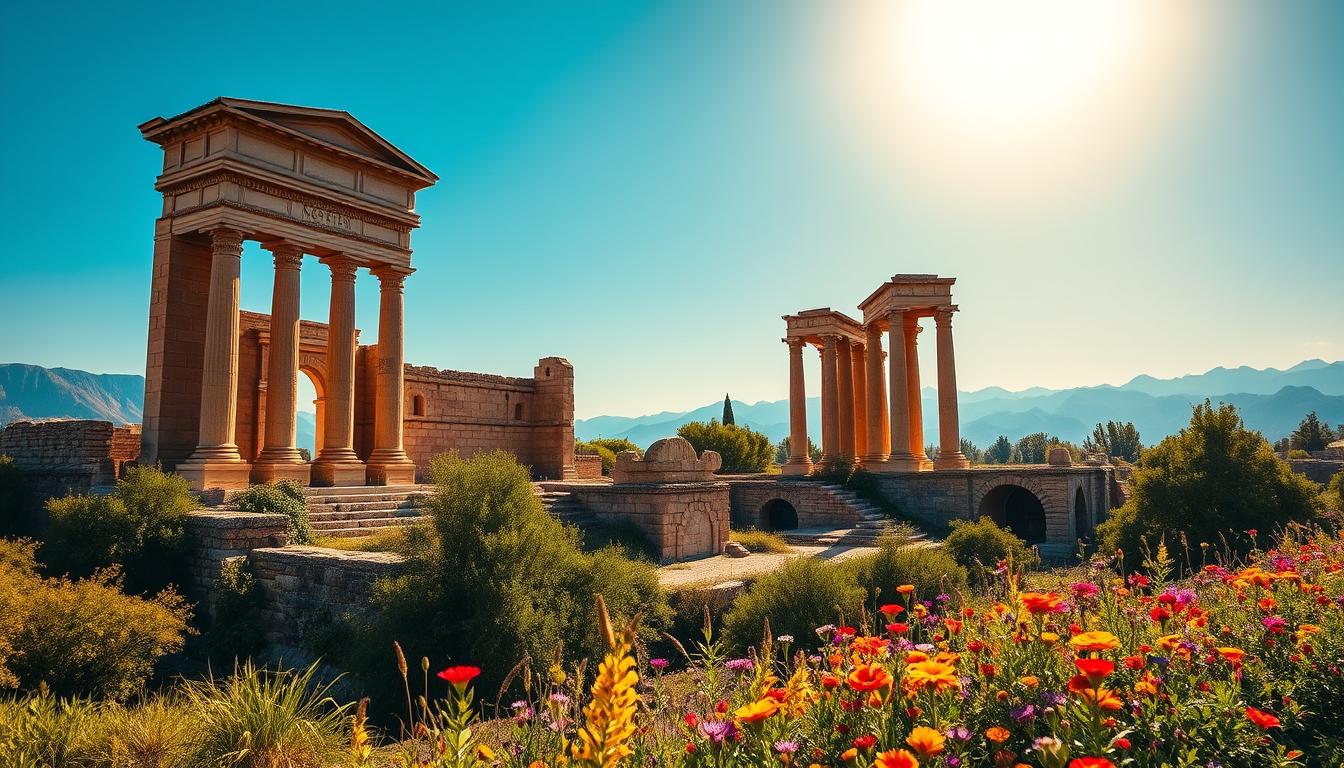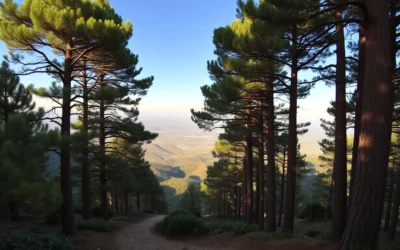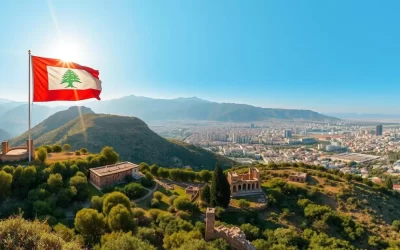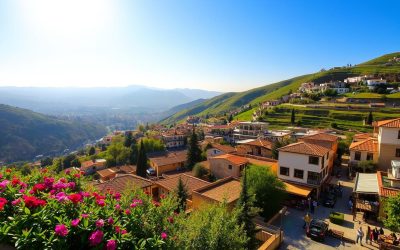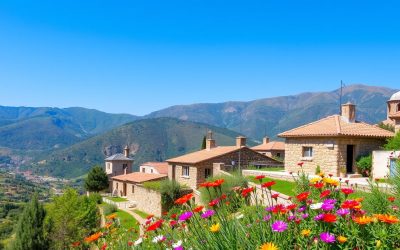Ever wondered about the secrets in Baalbek’s ancient Roman ruins? This UNESCO World Heritage Site is perfect for history lovers and adventurous travelers. Located in the beautiful Beq’aa Valley, Baalbek’s temples and stonework show the Roman Empire’s architectural greatness.
The weathered stones of Baalbek tell amazing stories. Discover the site’s history and cultural importance as you see its temples, courtyards, and quarries. Be amazed by the massive scale and detailed craftsmanship that has lasted for centuries.
Key Takeaways
- Baalbek is a UNESCO World Heritage Site in Lebanon’s Beq’aa Valley, known for its impressive Roman ruins.
- The site features temples dedicated to the Roman gods Venus, Jupiter, Bacchus, and Mercury.
- Visitors can marvel at the colossal scale and ornate details of the Temple of Jupiter and Temple of Bacchus.
- Baalbek’s history spans multiple civilizations, from Phoenician to Roman, Umayyad, and Crusader eras.
- Exploring the ancient quarries and ceremonial courtyards offers a deeper understanding of Baalbek’s rich past.
Introduction to the Ancient City of Baalbek
Baalbek is in Lebanon’s Beqaa Valley. It has a history of over 9,000 years. This ancient Roman city, once Heliopolis, is famous for its temples and ruins.
Brief History of Heliopolis
The history of Baalbek goes back to the Phoenician era, around 2000 BCE. It was known as Heliopolis under Greek rule. But it reached its peak during the Roman era, with the building of its temples.
UNESCO World Heritage Status
In 1984, UNESCO named Baalbek a World Heritage Site. This honor highlights its cultural and historical importance. It’s a key place to see in Lebanon.
Location and Getting There
Baalbek is about 85 kilometers northeast of Beirut. It takes about two hours by car. The entry fee is $10 USD. Guided tours start at $55 USD and include transportation and a guide.
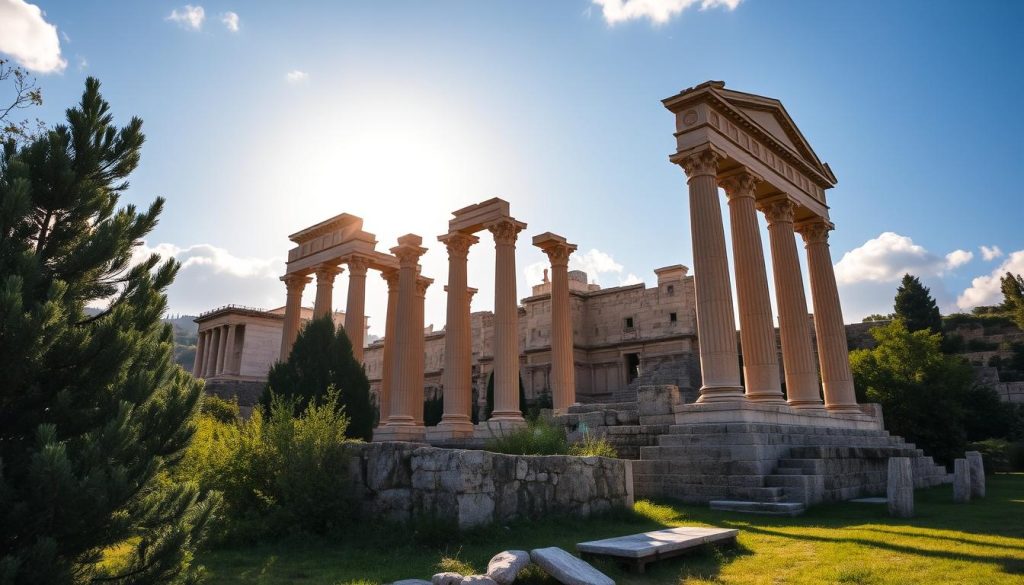
“The stones used in the construction of the Baalbek Temples weigh up to (and over) 800 tons, a true testament to the engineering prowess of the ancient Romans.”
The Magnificent Temple of Jupiter
The Temple of Jupiter is a gem in the ancient ruins of Baalbek, Lebanon. It shows the Roman Empire’s skill in building. Once the biggest in Baalbek, it had 54 huge columns. Now, only six stand tall, each 22 meters (72 feet) high.
The temple’s base is amazing, made with huge stones, some as heavy as 800 tons. These stones formed a wall that kept the temple stable and prevented soil erosion.
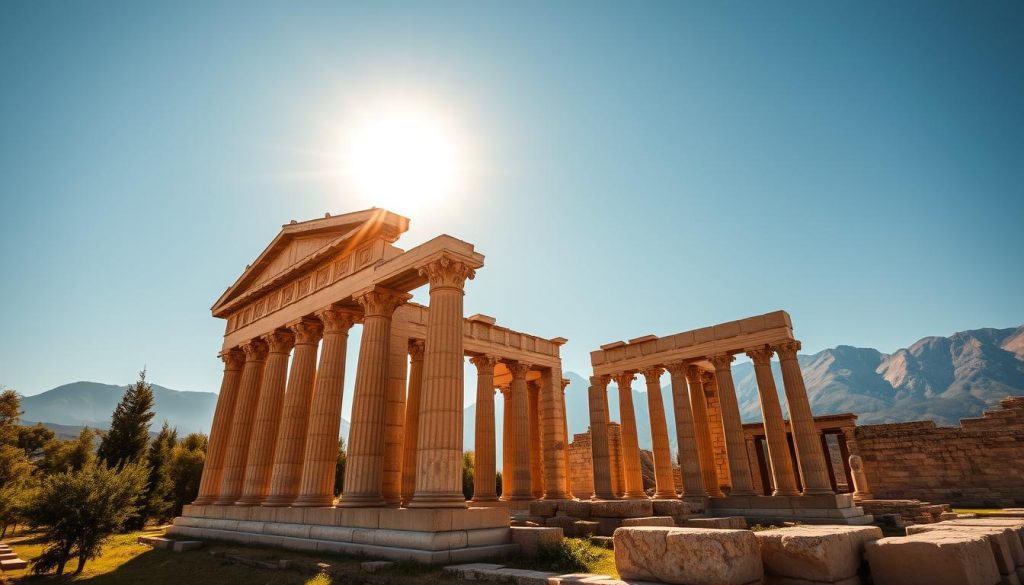
The Temple of Jupiter’s size and beauty show Roman architectural genius. Visitors are amazed by the huge columns that once held up the roof. Exploring the ruins, you can imagine the hard work needed to build such a massive structure here.
“The Temple of Jupiter at Baalbek is a stunning example of Roman architectural prowess, showcasing the empire’s ability to create colossal and visually stunning structures, even in remote locations.”
The Temple of Jupiter and the Baalbek complex are UNESCO World Heritage Sites. Walking through these ruins, you feel like you’ve traveled back in time. You marvel at the Roman Empire’s engineering and lasting legacy.
Temple of Bacchus: Architectural Marvel
In the ancient city of Baalbek, Lebanon, the Temple of Bacchus is a stunning Roman architecture gem. This temple, a UNESCO World Heritage site, is remarkably preserved. It impresses visitors with its tall Corinthian columns and detailed stone carvings.
Interior Design Features
When you enter the Temple of Bacchus, you’ll be amazed by its grand interior. The temple’s high walls, with Corinthian columns over 20 meters tall, feel majestic. The walls and ceilings are decorated with Roman mythology scenes, showing the ancient builders’ artistry.
Ornate Stone Carvings
The Temple of Bacchus is famous for its stunning stone carvings. These carvings, made by Roman architects and artisans, are incredibly detailed. They cover the walls and columns, offering a breathtaking view. These stone carvings add beauty and reveal the site’s cultural and religious importance.
Conservation Status
Despite time and conflict, the Temple of Bacchus remains structurally sound. International efforts have helped preserve this architectural wonder. This ensures that future generations can see the Corinthian columns and appreciate the Roman architecture of Baalbek’s past.
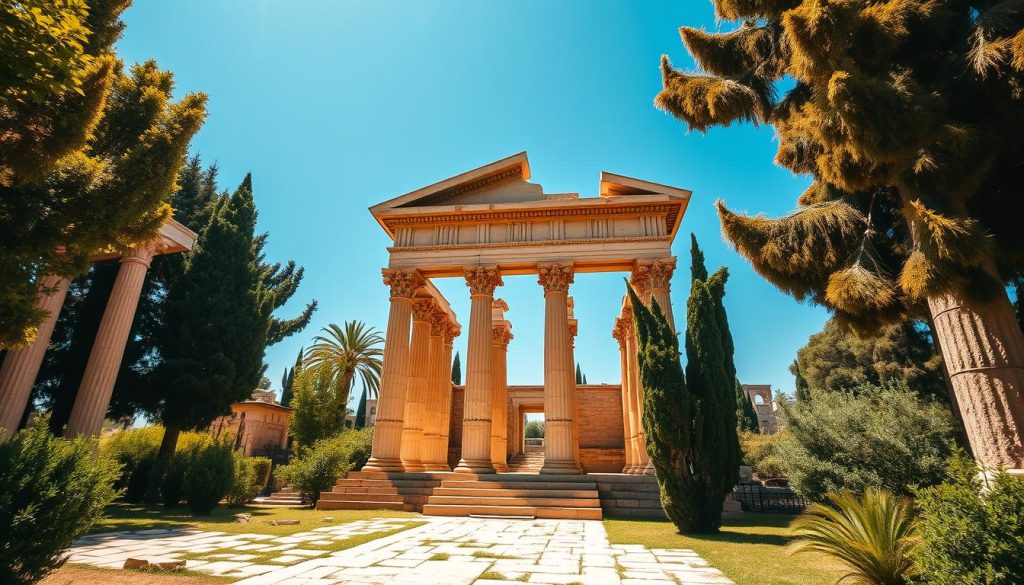
“The Temple of Bacchus in Baalbek is a testament to the enduring legacy of Roman engineering and artistry. Its well-preserved state and intricate stone carvings offer a captivating glimpse into the past, inspiring awe and wonder in all who visit.”
The Temple of Venus and Its Significance
In the heart of Baalbek, Lebanon, lies the Temple of Venus. It’s a symbol of the Roman fertility goddess and a key part of the site’s history. This small, round temple is the smallest of the three temples left at Baalbek. Yet, it’s very important to both visitors and scholars.
The Temple of Venus was dedicated to Venus, the goddess of love and fertility. It was a key place for ancient religious ceremonies. People can see the temple from outside a fence. This lets them enjoy its beauty and history from a safe distance.
The Temple of Venus, along with the Temple of Bacchus and the huge Temple of Jupiter, made up a group of temples at Baalbek. Each was dedicated to a different Roman god. Together, they are a UNESCO World Heritage Site. They show the amazing engineering and architecture of the Roman Empire at its best.
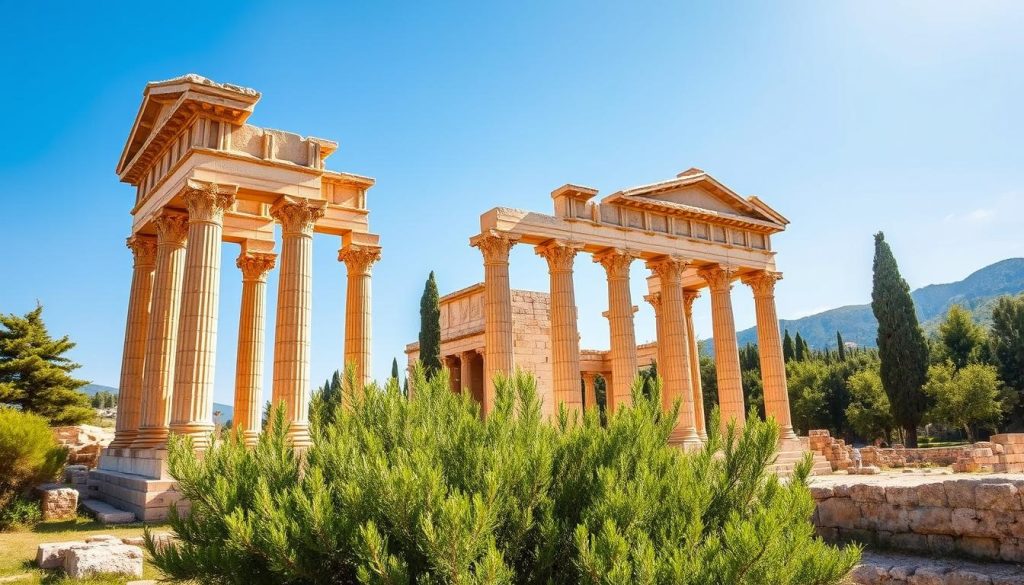
When you visit the Baalbek ruins, the Temple of Venus is a powerful reminder. It shows the site’s strong ties to the Roman fertility goddess. And it highlights the lasting importance of these ancient religious sites in the area’s history.
Exploring the Great Court Complex
Baalbek’s site is more than just temples. It has a huge Great Court Complex that shows the grandeur of ancient Roman spaces. At its center is the Hexagonal Courtyard, once surrounded by 30 columns.
The Great Court was a big plaza with buildings and altars around it. Though time has worn them down, they still show the site’s importance. They make us think of the big rituals and parades that happened here.
The Hexagonal Courtyard
The Hexagonal Courtyard was a special entrance to the temple area. Its unique shape and columns make it a striking sight. It takes us back to the grand Roman designs of the past.
Ceremonial Entrances
Walking through the Great Court, you see the 20th-century steps to the Temple of Jupiter’s entrance. These steps show the site’s grand scale and importance. They hint at the amazing rituals and parades that happened here.
Ancient Altars
Throughout the Great Court, you find old altars. They give us a peek into the religious activities of the past. These weathered structures, with their detailed carvings, connect us to the rituals and offerings made before the temples.
Exploring the Great Court Complex, you feel the past come alive. It invites you to picture the grandeur and importance of this amazing archaeological site in Lebanon.
| Baalbek’s Key Archaeological Highlights | Description |
|---|---|
| Temple of Jupiter | The largest and most impressive temple in the complex, dedicated to the Roman god Jupiter. |
| Temple of Bacchus | An architectural marvel with intricate stone carvings and well-preserved interior design. |
| Temple of Venus | A temple dedicated to the Roman goddess of love, Venus, showcasing the site’s religious significance. |
| Great Court Complex | A vast ceremonial space featuring the Hexagonal Courtyard, ceremonial entrances, and ancient altars. |
Roman Quarries and Stone of the Pregnant Woman
Near the ancient city of Baalbek, Lebanon, is a remarkable Roman quarry called Hajjar al-Hibla. It’s famous for its huge megalithic stones used in the city’s temples. The “Stone of the Pregnant Woman” is a standout, measuring 20 meters long and weighing about 1,000 tons.
The size and weight of these Roman quarry stones show the ancient builders’ incredible skill. The megalithic stones in Baalbek are even bigger than the blocks in the Egyptian pyramids. The largest stone in the Egyptian pyramids weighs only 90 tons, much less than Baalbek’s stones.
The ancient engineering methods to move these massive stones are still amazing today. Scholars and visitors are impressed by how the ancient people used angled cutting and pulleys to move the Stone of the Pregnant Woman and other huge blocks.
| Measurement | Statistic |
|---|---|
| Dimensions of the Trilithon stones | 21 x 5 x 4 meters |
| Weight of the Trilithon stones | Approximately 800 tons each |
| Weight of the Stone of the Pregnant Woman | Approximately 1,600 tons |
| Weight of the largest stone in the Egyptian pyramids | 90 tons |
The Stone of the Pregnant Woman was meant to be moved 900 meters. This shows the huge ambition of the ancient projects in Baalbek. Recently, archaeologists found an even bigger stone, called the “Forgotten Stone,” which weighs about 1,497 tons.
The Roman quarry sites and the huge stones they produced still amaze people visiting Baalbek. The ancient builders’ skill and ambition are truly impressive.
Baalbek, Lebanon: Best Things to Do – Top Picks
Baalbek in Lebanon is a city filled with history. It’s home to some of the most important Roman ruins in the Middle East. These sites are so impressive that they are a UNESCO World Heritage site.
Essential Attractions
The Temple of Jupiter is a standout in Baalbek. It’s a massive temple from the Roman era. Its huge columns and detailed carvings show the skill of ancient builders.
The Temple of Bacchus is another must-see. It’s famous for its beautiful interior and stone reliefs. These details make it a true architectural wonder.
The Temple of Venus is great for those interested in ancient religions. It shows how the goddess of love was worshipped back then. The Great Court Complex also offers a lot to see. It has a courtyard, ceremonial entrances, and ancient altars.
Guided Tour Options
- Guided tours from Beirut are a favorite among visitors. They provide expert insights into the site’s history and design. This makes the ruins even more fascinating.
- Some tours also visit other Lebanese attractions. Places like the Ksara Winery or Anjar are included. This gives a full view of Lebanon’s Lebanese tourism scene.
Visiting Baalbek on your own or with a guide is a must. This UNESCO-listed site is perfect for anyone interested in Baalbek attractions and historical sites in Lebanon.
Best Time to Visit and Practical Tips
Planning your Baalbek travel in Lebanon requires careful timing. The spring (April to May) or fall (September to November) seasons are ideal. These periods offer mild and pleasant temperatures. Summer can be too hot for comfortable sightseeing.
Before your visit to Baalbek and exploring Lebanon, remember a few tips. Carry cash since many places don’t accept credit cards. Also, check the latest travel advisories. Lebanon is currently at Level 3 (Reconsider Travel). Yet, many find it safe and welcoming.
| Statistic | Value |
|---|---|
| Number of major tourist attractions mentioned in the travel guide | 9 |
| Percentage of attractions that are ancient historic sites | 44% (4 out of 9) |
| Number of cities highlighted as must-visit locations | 5 |
| Number of sites particularly recommended for overnight stays | 2 |
| Percentage of attractions located near Beirut | 56% (5 out of 9) |
With these Baalbek travel tips and Lebanon tourism tips, you’re ready. You’ll have a safe and enjoyable visit planning experience in this amazing place.
Photography Spots and Viewpoints
Baalbek, the ancient Phoenician city, is a treasure trove for photographers. It offers many spots to capture the grandeur of its Roman ruins. Make sure to explore the best viewpoints, especially during sunrise and sunset.
Sunrise and Sunset Locations
The Great Court is a must-see. It features the majestic Temple of Jupiter at its center. This spot is perfect for capturing the city’s beauty during sunrise and sunset. The warm light creates stunning images that capture Baalbek’s essence.
Best Angles for Temple Photography
To showcase the Temple of Bacchus’s beauty, try different angles and perspectives. Capture the temple from various distances and heights. This highlights its architectural wonders, like the detailed stone carvings and massive columns.
The site’s vastness lets you create unique shots. You can contrast the ancient ruins with the modern sky. This contrast makes for captivating images.
The above is subject to change.
Check back often to TRAVEL.COM for the latest travel tips and deals.
Here are some Tours & Sightseeing suggestions that might pique your interests!
